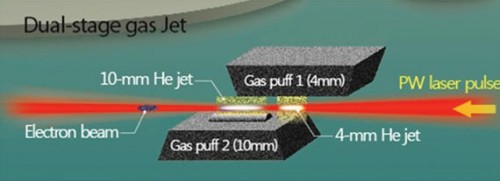
Schematic showing the laser passing through the two gas jets.
(Courtesy: Hyung Taek Kim et al. Phys. Rev. Lett. 111 165002)
By Hamish Johnston
There is an interesting paper in Physical Review Letters this week with the mouthful of a title: “Enhancement of electron energy to the multi-GeV regime by a dual-stage laser-wakefield accelerator pumped by petawatt laser pulses“. This piqued my interest because I recently wrote an article for the 25th anniversary issue of Physics World that looks at how laser acceleration of protons and other hadrons could make certain cancer therapies more accessible.
The idea is that charged particles such as electrons are accelerated by the huge electric fields that are generated when an intense laser pulse interacts with a target. In the case of a laser-wakefield accelerator (LWFA), the target is a jet of gas.
Physicists have already accelerated electrons to kinetic energies of hundreds of megaelectronvolts, but breaking the gigaelectronvolt barrier has proven difficult. One technique that is showing great promise is to do the acceleration in two stages by firing a laser pulse through two successive gas targets. Electrons accelerated in the first target follow the laser pulse into the second target, where they are given a second boost.
This approach was taken in 2011 by researchers in China who managed to create a beam with an energy profile centred at about 800 MeV, but with a tail reaching up to about 1 GeV. That work is also described in Physical Review Letters in “All-optical cascaded laser wakefield accelerator using ionization-induced injection“.
In the paper published this week, Tae Moon Jeong, Jongmin Lee and colleagues at the Advanced Photonics Research Institute Gwangju, Korea, have used a dual-stage technique to create electrons with energies up to about 3 GeV. In their experiment, the electrons are accelerated to 400 MeV in the first gas jet and then travel a few millimetres to the second gas jet. The electrons are moving at very nearly the speed of light so keep pace with the laser light, arriving at the second jet just in time to be accelerated again.
While 3 GeV is impressive, one important goal of this research is to create a multiple-stage LWFA that can create electrons with energies beyond 100 GeV. Such an accelerator could be used to create ultrashort pulses of X-rays, which could be useful for materials science, chemistry and biology. And if electrons with energies of about 250 GeV can be created, they could be smashed together to provide more information about the Higgs boson.
You can download a free PDF copy of the 25th anniversary issue of Physics World and read more about laser-driven particle acceleration in the article “Physics for our future” on page 50.
With the multistage laser-wakeful accelerator for particles such as electrons reaching some GeV’s, the technology progressing quite fast. However, these accelerators intrinsically suffer from low partical intensities. Hence, even, if they reach hundreds of GeV’s, their lumonosity will remain very low for particle physics.
Sounds good to me.
I hope the technology does progress fast. I’m not keen on spending big money on big-science constructions, like the next big collider. Or should I say I feel the big money might be better spent on other science activities.
Trackback: Laser accelerator breaks the gigaelectronvolt barrier | Alin Velea